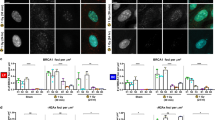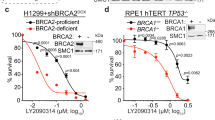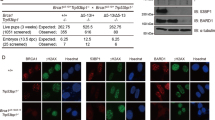Abstract
Germline mutation of the BRCA2 gene carries a high risk of developing breast cancer. To study the function of this gene, we generated a mutation in Brca2 in mice. Unlike other mutations in the Brca2 gene, which are lethal early in embryogenesis when homozygous, some of our homozygous mutant mice survive to adulthood. These animals have a wide range of defects, including small size, improper differentiation of tissues, absence of germ cells and the development of lethal thymic lymphomas. Fibroblasts cultured from Brca2−/−embryos have a defect in proliferation that may be mediated by over-expression of p53 and p21waf1/Clp1. We show that Brca2 is required for efficient DNA repair, and our results suggest that loss of the p53 checkpoint may be essential for tumour progression triggered by mutations in BRCA2.
This is a preview of subscription content, access via your institution
Access options
Subscribe to this journal
Receive 12 print issues and online access
$209.00 per year
only $17.42 per issue
Buy this article
- Purchase on Springer Link
- Instant access to full article PDF
Prices may be subject to local taxes which are calculated during checkout
Similar content being viewed by others
References
Szabo, C.A. & King, M.-C. Inherited breast and ovarian cancer. Hum. Mol. Genet. 4, 1811–1817 (1995).
Stratton, M.R. & Wooster, R. Hereditary predisposition to breast cancer. Curr. Opin. Genet. Dev. 6, 93–97 (1996).
Easton, D. Breast cancer genes—e the real risks?. Nature Genet. 16, 210–211 (1997).
Hall, J.M. et al. Linkage of early−onset familial breast cancer to chromosome 17q21. Scince. 250, 1684–1689 (1990).
Miki, Y. et al. A strong candidate for the breast and ovarian cancer susceptibility gene BRCA1. Scince. 266, 66–71 (1994).
Wooster, R. et al. Localization of a breast cancer susceptibility gene, BRCA2, to chromosome 13q12–13. Science 265, 2088–2090 (1994).
Wooster, R. et al. Identification of the breast cancer susceptibility gene BRCA2. Nature. 378, 789–792 (1995).
Futreal, P.A. et al. BRCA1 mutations in primary breast and ovarian carcinomas. Science. 266, 120–122 (1994).
Lancaster, J.M. et al. BRCA2 mutations in primary breast and ovarian cancers. Nature Genet. 13, 238–240 (1996).
Miki, Y., Katagiri, T., Kasumi, F., Yoshimoto, T. & Nakamura, Y. Mutation analysis in the BRCA2 gene in primary breast cancers. Nature Genet. 13, 245–247 (1996).
Teng, D.H.-F. et al. Low incidence of BRCA2 mutations in breast carcinoma and other cancers. Nature Genet. 13, 241–244 (1996).
Tavtigian, S.V. et al. The complete BRCA2 gene and mutations in chromosome 13q-linked kindreds. Nature Genet. 12, 333–337 (1996).
Gayther, S.A. et al. Variation of risks of breast and ovarian cancer associated with different mutations of the BRCA2 gene. Nature Genet. 15, 103–105 (1997).
Bork, P., Blomberg, N. & Nilges, M. Internal repeats in the BRCA2 protein sequence. Nature Genet. 13, 22–23 (1996).
Bignell, G., Micklem, G., Stratton, M.R., Ashworth, A. & Wooster, R. The BRC repeats are conserved in mammalian BRCA2 proteins. Hum. Mol. Genet. 6, 53–58 (1997).
Connor, F. et al. Cloning, chromosomal mapping and expression pattern of the mouse Brca2 gene. Hum. Mol. Genet. 6, 291–300 (1997).
Sharan, S.K. & Bradley, A., Murine Brca2: sequence, map position, and expression pattern. Genomics 40, 234–241 (1997).
Rajan, J.V., Wang, M., Marquis, S.T. & Chodosh, L.A. Brca2 is coordinately regulated with Brcal during proliferation and differentiation in mammary epithelial cells. Proc. Natl. Acad. Sci. USA. 93, 13078–13083 (1996).
Vaughn, J.P. et al. Cell cycle control of BRCA2. Cancer Res. 56, 4590–4594 (1996).
Scully, R. et al. Association of BRCA1 with Rad51 in mitotic and meiotic cells. Cell. 88, 265–275 (1997).
Sharan, S.K. et al. Embryonic lethality and radiation hypersensitivity mediated by Rad51 in mice lacking Brca2. Nature. 386, 804–810 (1997).
Game, J.C. DMA double−stranded breaks and the RAD50−RAD57 genes in Saccharomyces. Semin.Cancer Biol. 4, 73–83 (1993).
Ivanov, E.L. & Haber, J.E. DNA repair: RAD alert. Curr. Biol. 7, 492–4956 (1997).
Chapman, M.S. & Verma, I.M. Transcriptional activation by Brcal. Nature. 382, 678–679 (1996).
Milner, J., Ponder, B., Hughes−Davies, L., Seltmann, M. & Kouzarides, T. Transcriptional activation functions in BRCA2. Nature. 386, 772–773 (1997).
Scully, R. et al. BRCA1 is a component of the RNA polymerase II holoenzyme. Proc. Natl, Acad. Sci. USA 94, 5605–5610 (1997).
Ludwig, T., Chapman, D.L., Papaioannou, V.E. & Efstratiadis, A. Targeted mutations of breast cancer susceptibility gene homologs in mice: lethal phenotypes of Brcal, Brca2, Brca1/Brca2, Brca1/p53, and Brca2lp53 nullizygous embryos. Genes Dev. 11, 1226–1241 (1997).
Suzuki, A. et al. Brca2 is required for embryonic cellular proliferation in the mouse. Genes Dev. 11, 1242–1252 (1997).
Doetschman, T.C., Eistetter, H., Katz, M., Schmidt, W. & Kemler, R. The in vitro development of blastocyst−derived embryonic stem cell lines: formation of visceral yolk sac, blood islands and myocardium. J. Embryol. Exp. Morphol. 87, 27–45 (1985).
Hakem, R. et al. The tumor suppressor gene Brca1 is required for embryonic cellular proliferation in the mouse. Cell 85, 1009–1023 (1996).
Lu, X. & Lane, D.P. Differential induction of transcriptionally active p53 following UV or ionizing radiation: defects in chromosome instability syndromes? Cell 75, 765–778 (1993).
Ross, G.M. et al. DNA strand break rejoining defect in xrs-6 is complemented by transfection with the human Ku80 gene. Cancer Res. 55, 1235–1238 (1995).
Gowen, L.C., Johnson, B.L., Latour, A.M., Sulik, K.K. & Koller, B.H. Brcal deficiency results in early embryonic lethality characterized by neuroepithelial abnormalities. Nature Genet. 12, 191–194 (1996).
Liu, C.Y., Flesken-Nikitin, A., Li, S., Zeng, Y. & Lee, W.H. Inactivation of the mouse Brca1 gene leads to failure in the morphogenesis of the egg cylinder in early postimplantation development. Genes Dev. 10, 1835–1843 (1996).
Thorlacius, S. et al. A single BRCA2 mutation in male and female breast cancer families from Iceland with varied cancer phenotypes. Nature Genet. 13, 117–119 (1996).
Montes de Oca Luna, R., Wagner, D.S. & Lozano, G. Rescue of early embryonic lethality in mdm2-deficient mice by deletion of p53. Nature 378, 203–206 (1995).
Jones, S.N., Roe, A.E., Donehower, L.A. & Bradley, A. Rescue of embryonic lethality in Mdm2-deficient mice by absence of p53. Nature 378, 206–208 (1995).
Godley, L.A. et al. Wid−type p53 transgenic mice exhibit altered differentiation of the uteric bud and possess small kidneys. Genes Dev. 10, 836–850 (1996).
Xu, Y. et al. Targeted disruption of ATM leads to growth retardation, chromosomal fragmentation during meiosis, immune defects, and thymic lymphoma. Genes Dev. 10, 2411–2422 (1996).
Barlow, C. et al. Atm-deficient mice: a paradigm of ataxia telangiectasia. Cell. 86, 159–171 (1996).
Elson, A. et al. Pleiotropic defects in ataxia−telangiectasia protein−deficient mice. Proc. Natl. Acad. Sci. 93, 13084–13809 (1996).
Meyn, S. Ataxia−telangiectasia and cellular responses to DNA damage. Cancer Res. 55, 5991–6001 (1995).
Swift, M., Reitnauer, P., Morrell, D. & Chase, C. Breast and other cancers in families with ataxia telangiectasia. N. Engl. J. Med. 316, 1289–1294 (1987).
Fitzgerald, M.G. et al. Heterozygous ATM mutations do not contribute to early onset of breast cancer. Nature Genet. 15, 307–310 (1997).
Bishop, D.T. & Hopper, J. AT-attributable risks? Nature Genet. 15, 226 (1997).
Westphal, C.H. et al. Genetic interactions between atm and p53 influence cellular proiferation and irradiation−induced cell cycle checkpoints. Cancer Res. 57, 1664–1667 (1997).
Kinzler, K.W. & Vogelstein, B. Gatekeepers and caretakers. Nature. 386, 761–763 (1997).
Brugarolas, J. & Jacks, T., Indemnity: p53, BRCA and cancer. Nature Med. 3, 721–722 (1997).
Crook, T., Crossland, S., Crompton, M.R., Osin, P. & Gusterson, B.-A. p53 mutations in BRCA1-associated familial breast cancer. Lancet 350, 638–639 (1997).
Fukasawa, K., Choi, T., Kuriyama, R., Rulong, S. & Vande Woude, G.F. Abnormal centrosome amplification in the absence of p53. Science. 271, 1744–1747 (1996).
Tybulewicz, V.L.J., Crawford, C.E., Jackson, P.K., Bronson, R.T. & Mulligan, R.C. Neonatal lethality and lymphopenia in mice with a homozygous disruption of the c-abl proto-oncogene. Cell. 65, 1153–1163 (1991).
Karaplis, A.C. et al. Lethal skeletal dysplasia from targeted disruption of the parathyroid hormone−related peptide gene. Genes Dev. 8, 277–289 (1994).
Robertson, E.J. Embryo-derived stem cell lines, in Teratocarcinomas and Embryonic Stem Cells. A Practical Approach (ed. Robertson, E.J.) 71–112 (IRL, Oxford, 1987).
Bradley, A. Production and analysis of chimaeric mice, in Teratocarcinomas and Embryonic Stem Cells. A Practical Approach (ed. Robertson, E.J.) 113–151 (IRL, Oxford, 1987).
Author information
Authors and Affiliations
Rights and permissions
About this article
Cite this article
Connor, F., Bertwistle, D., Mee, P. et al. Tumorigenesis and a DNA repair defect in mice with a truncating Brca2 mutation. Nat Genet 17, 423–430 (1997). https://doi.org/10.1038/ng1297-423
Received:
Accepted:
Issue Date:
DOI: https://doi.org/10.1038/ng1297-423
This article is cited by
-
BRCA2 binding through a cryptic repeated motif to HSF2BP oligomers does not impact meiotic recombination
Nature Communications (2021)
-
Cell-cycle arrest and senescence in TP53-wild type renal carcinoma by enhancer RNA-P53-bound enhancer regions 2 (p53BER2) in a p53-dependent pathway
Cell Death & Disease (2021)
-
BRCA2 abrogation triggers innate immune responses potentiated by treatment with PARP inhibitors
Nature Communications (2019)
-
Breast cancer protection by genomic imprinting in close kin families
BMC Medical Genetics (2017)
-
Tissue-specific tumorigenesis: context matters
Nature Reviews Cancer (2017)



